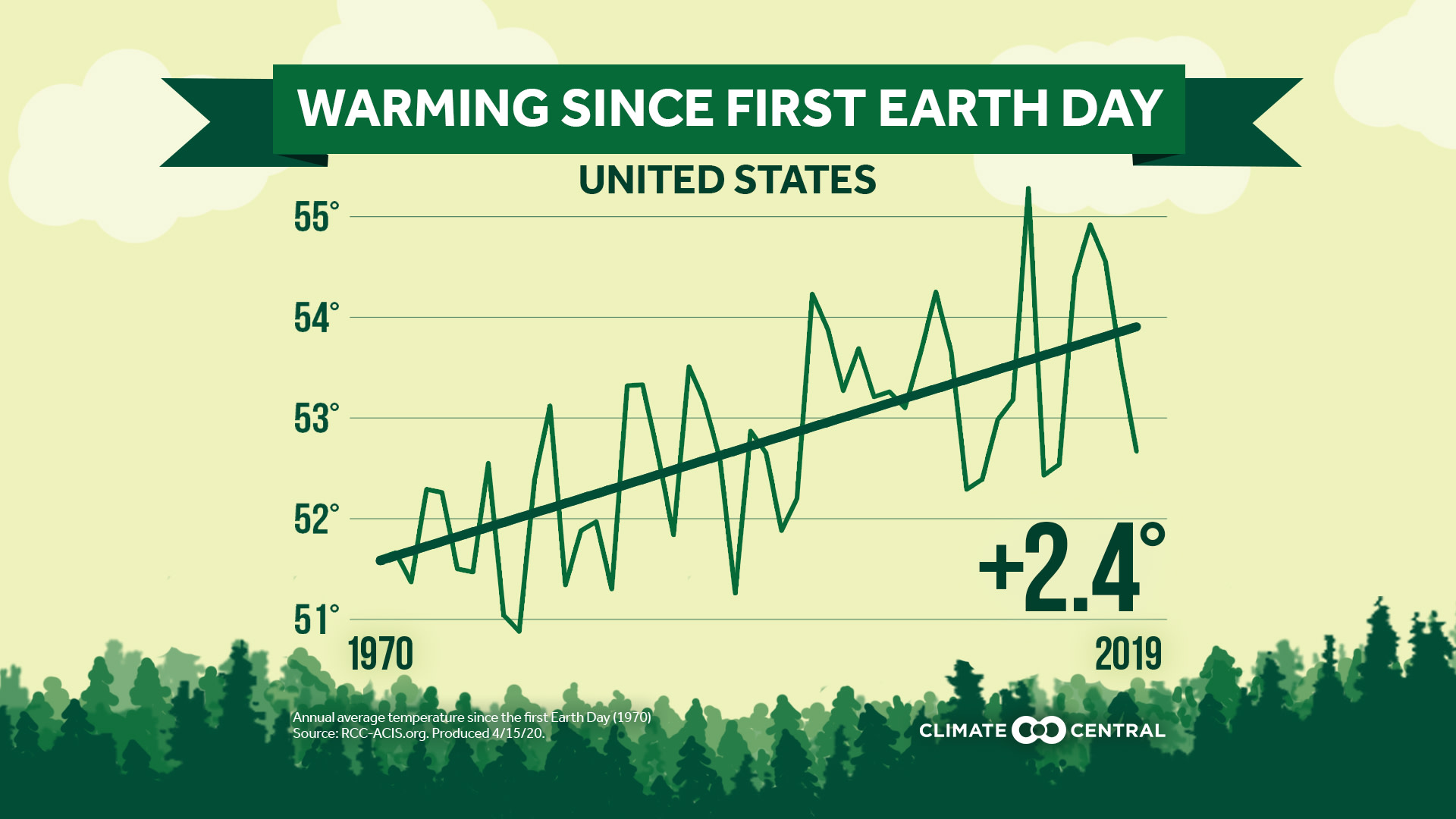KEY CONCEPTS
As COVID-19 has shown, we are all connected on one Earth. Science-guided information and swift actions are essential, both individually and collectively—key lessons for climate change too.
One way to advance solutions is to talk about them. This Earth Week, the Covering Climate Now initiative is hosting a “Joint Coverage Week” for climate change solutions.
We’ve also updated our popular city trends package, plotting annual temperatures since the first Earth Day 50 years ago.
And for those looking to engage audiences from afar, we’ve compiled some content that’s fit for Environmental Education Week (also April 20-24) and beyond.
READY-TO-USE GRAPHICS
With the global response to COVID-19, it’s clear that we really are all connected on one Earth. Today’s global impacts foreshadow the accelerating and compounding hazards that climate change poses to our health, economy, and ways of life. But current events also show what our world can do when we work together to solve an issue, using the power of science-based guidance—both at the individual and collective levels.
Earth Day’s 50th anniversary is a fitting time for these reflections. On the first Earth Day in 1970, involvement from 20 million people paved the way for cleaner air, cleaner water, and more protected land. If similar efforts reduced human-caused greenhouse gas emissions, we could “flatten the curve” of rising temperatures as well.
EARTH DAY TEMPERATURE TRENDS
Temperature trends aren’t flattening yet. In the above graphics, we show how annual temperatures have changed since the first Earth Day, locally and nationally. Temperatures have risen in 98% of the 242 cities analyzed, while the contiguous U.S. has warmed 2.4°F in those 50 years. Reno, Nev. leads this year’s cities with an increase of 7.4°F, followed by Las Vegas, Nev. (5.5°F) and El Paso, Texas (4.8°F). Many of the fastest-warming cities are in the Southwest, where spring is also the fastest-warming season. For more info, see our methodology or full rankings.
COVERING CLIMATE NOW: CLIMATE SOLUTIONS
This Earth Week, Covering Climate Now is encouraging climate solutions stories in a “Joint Coverage Week” with more than 400 partner media outlets. Aside from the perk of spreading optimism in these difficult times, solutions stories have many benefits. According to research from Solutions Journalism Network, these stories can capture viewers’ attention for longer and are more likely to be shared. They also increase understanding and involvement in the issue itself (see more in a past webinar).
Here are some solution-based resources from our searchable media library.
Local, customizable graphics from our WeatherPower tool, which forecasts wind and solar electricity generation based on existing installations and local weather.
Electricity: Solar is Shining, Solar and Wind Potential, Rise of Renewables
Transportation: Battery Storage, , Transportation Emissions
Other: Trees Fighting Floodwaters, Carbon Farming, Prescribed Burns Brief
And from our partners at Project Drawdown, which ranks solutions by their projected global impact:
Full table of solutions (updated in February)
Solutions by sector
Climate Teaching Collections based on the original report
To become a Covering Climate Now partner, click here.
RESOURCES FOR LOCAL REPORTING
How is local warming affecting your area? Check out Climate Central’s extreme weather toolkits, or read your regional breakdown from the National Climate Assessment.
How is your community responding with climate solutions? Search the Solutions Story Tracker, find ideas from Covering Climate Now, or see if your area is part of a group like Climate Mayors.
How are people celebrating Earth Day during COVID-19? Check if any groups near you are engaging in other ways—like the Earth Challenge 2020app for citizen science.
CONTENT FOR ENVIRONMENTAL EDUCATION WEEK
In this time of social distancing, many are embracing the chance to enjoy nature—whether from a window or on a walk (where it is safe to do so). Below are some nature-focused Climate Matters releases to engage your audience. In addition, check out the many resources for National Environmental Education Week from NEEF, including suggested home activities like virtual park and museum visits, activity guides, and citizen science projects.
The Power of Trees
Your Changing Allergy Season
Planting Zones Moving North
Mosquito Danger Days
Poison Ivy
Flowers & Hummingbirds
METHODOLOGY
Average annual temperature from the Applied Climate Information System. Trends are based on a mathematical linear trend line, beginning in 1970 for consistency between stations. Reno, Nev. was included this year after consulting with Nevada’s state climatologist. Only 242 of our 244 stations are included in summary statements due to large data gaps in St. Johnsbury, Vt. and Wheeling, W. Va.
